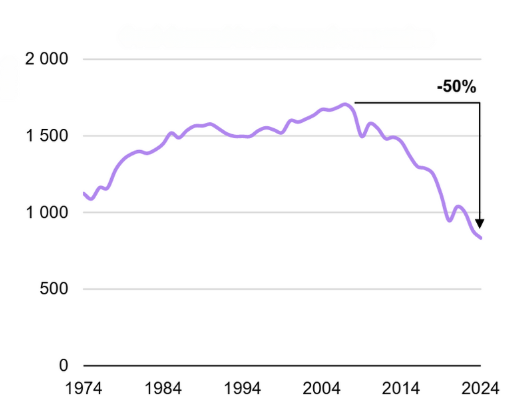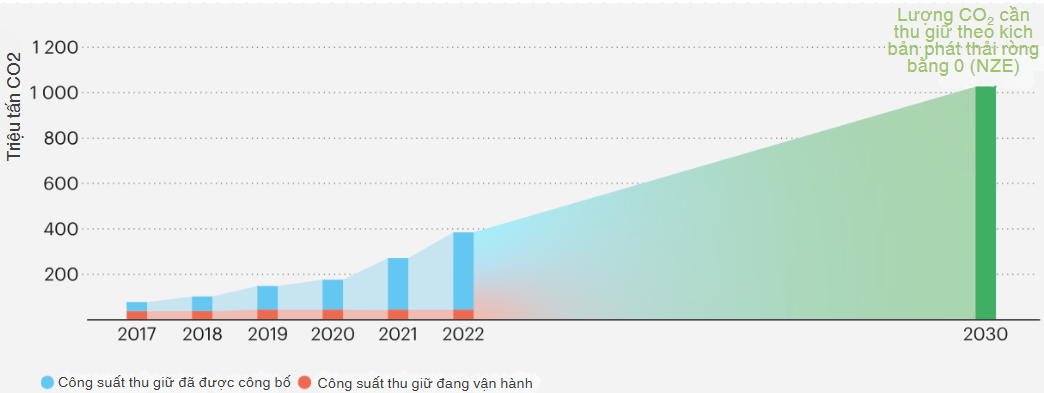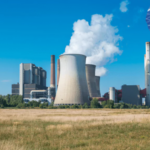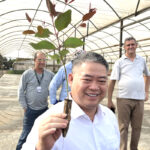Coal-fired Power and CCS: Expectations and Reality
Despite efforts to transition to cleaner energy sources, coal-fired power remains significant in the global energy mix. According to the IEA’s Global Energy Review 2025, the share of coal-fired power in global electricity production stands at 35% – the lowest since IEA’s inception in 1974[1]. This poses a challenge for countries in reducing greenhouse gas emissions, especially as new coal-fired power plants are still being built in emerging and developing economies.
|
Coal demand in advanced economies (1974–2024)
Source: International Energy Agency (IEA), Global Energy Review 2025, page 20
|
The chart illustrates a 50% decline in coal demand in developed economies compared to its peak, reflecting a clear shift away from coal-fired power over the past half-century. In this context, CCS is regarded as a technology to reduce CO₂ emissions from existing coal-fired power plants. The comprehensive assessment report by the Intergovernmental Panel on Climate Change (IPCC) reaffirmed the necessity of CCS in achieving the Paris climate goals. This report concluded its 6-7-year reporting cycle by emphasizing CCS as an option in the pathways to limit global warming to 1.5°C[2].
Technically, CCS encompasses three main technologies applicable to coal-fired power:
- Post-combustion capture: Captures CO₂ from flue gases after fuel combustion, typically using chemical solvents to absorb CO₂.
- Pre-combustion capture: Converts fuel into a mixture of hydrogen and CO₂ before combustion, then separates CO₂ from the mixture.
- Oxy-fuel combustion: Burns coal in pure oxygen instead of air, producing emissions with higher CO₂ concentrations, making capture easier.
For instance, the Boundary Dam project in Canada, operational since 2014, converted Unit 3 at the Boundary Dam power plant into a facility producing 110-115MGW of reliable, long-duration clean electricity. The project is capable of capturing up to 1 megatonne of CO₂ annually, with a total investment cost of 1.24 billion USD[3].
However, despite initial expectations, the reality of implementing CCS in the coal industry faces limitations. According to the latest report by the Global CCS Institute, as of July 2023, only 41 CCS facilities are operational worldwide, with a total CO₂ capture and storage capacity of 49 million tonnes per year[4]. This accounts for a minuscule fraction (less than 0.1%) of global CO₂ emissions from the power sector, which amounts to billions of tonnes annually.
Why hasn’t CCS rescued coal-fired power?
According to IEA data, the cost of CO₂ capture in the power sector can range from 40-100 USD/tonne of CO₂, and even higher for small-scale projects[5]. This is significantly higher than the current carbon prices in most carbon markets, making CCS economically unviable without government support.
Secondly, CO₂ capture consumes a substantial amount of energy, resulting in what is known as an “efficiency penalty.” Installing a CCS system can decrease the efficiency of a coal-fired power plant, implying that to maintain the same level of electricity production, the plant would need to burn more coal, leading to higher operating costs and increased environmental impacts from coal extraction[6].
Notably, the CO₂ capture efficiency of current CCS systems often falls short of the expected “near-total” levels. Commercial projects today typically achieve capture rates ranging from 80-90%, implying that a significant portion of CO₂ is still released into the environment.
In terms of deployment scale, according to the IEA, to achieve Net Zero by 2050, the total CO₂ capture capacity needs to reach approximately 1,024 Mt by 2030 and increase to 6,040 Mt by 2050[7]. However, at the current pace of development, this target seems almost unattainable. In 2022, global CO₂ capture capacity stood at only about 45 Mt, with the power sector contributing a mere 1 Mt[8].
|
Gap between announced and actual CO₂ capture capacity compared to the Net Zero scenario (2017–2030)
Source: International Energy Agency (IEA), CCUS Report
|
Additionally, coal-fired power plants are typically built close to electricity consumption centers (often urban areas), while suitable CO₂ storage sites (deep geological formations) may be located hundreds of kilometers away. Constructing CO₂ transportation pipelines is costly and faces legal barriers and community acceptance challenges[9].
Lastly, while geological storage technology has been extensively studied, the possibility of CO₂ leakage from storage sites remains a concern. The IPCC’s special report on CCS highlighted health, safety, and environmental risks, as well as the issue of stored CO₂ leakage[10].
CCS in international policies and implementation
In the United States, the expansion of the 45Q tax credit for CCS in the Bipartisan Budget Act of 2018 provided a significant financial incentive for CCS deployment. According to the Clean Air Task Force (CATF) model, this policy could lead to the capture and storage of approximately 49 million tonnes of CO₂ annually from the power sector by 2030[11]. However, this figure only amounts to about two-thirds of the IEA’s target of 73.5 million tonnes of CO₂ for 2030[12].
Notably, a large portion of CCS funding in the United States, particularly through the Inflation Reduction Act (IRA), is directed towards heavy industries such as cement, steel, and chemicals, rather than the power sector. This reflects the growing recognition that CCS may have greater value in hard-to-abate sectors compared to the power sector, where more competitive alternatives like renewable energy exist.
In Europe, the EU focuses on accelerating the phase-out of coal and the transition to renewable energy. EU funding for CCS primarily targets heavy industries and green hydrogen, with little support for CCS projects in coal-fired power[13].
In Asia, in June 2023, China Energy commissioned a large-scale CCUS facility at the Taizhou power plant in Jiangsu Province. This project has the capacity to capture 500,000 tonnes of CO₂ annually and has become the largest CCUS project in Asia for the coal-fired power sector[14]. However, this scale is minuscule compared to the total CO₂ emissions from China’s coal-fired power sector, the world’s largest coal producer and consumer.
For developing countries, including Vietnam, implementing CCS faces even more challenges due to technological, financial, and legal constraints. While Vietnam has mentioned CCS in its Nationally Determined Contribution (NDC) and the National Power Development Plan (Power Plan VIII), no specific implementation plans have been announced. According to the World Bank’s climate and development report for Vietnam, climate change adaptation and carbon emission reduction solutions need to be integrated into the national development strategy[15].
On the other hand, according to the Global CCS Institute, project execution time must be reduced to achieve the necessary global deployment by 2030[16]. This requires countries to expedite permitting processes, community consultations, and project management.
The future of coal-fired power and CCS: Which alternative is more feasible?
In the past decade, the cost of electricity production from renewable energy sources, particularly wind and solar, has significantly decreased and is now cheaper than building new coal-fired power plants in many markets. According to McKinsey’s report, even without considering environmental externalities, renewable energy is becoming increasingly competitive[17]. When coupled with evolving energy storage technologies, renewable energy can gradually replace coal-fired power as the baseload electricity provider.
Meanwhile, CCS continues to face challenges in the power sector but holds greater potential in heavy industries such as cement, steel, and chemicals, where there are currently few effective alternatives to reduce CO₂ emissions. According to the Energy Transitions Commission, by 2050, the world may need to capture and store (or reuse) approximately 7-10 billion tonnes of CO₂ annually through technical solutions. Of this, about 3-5 billion tonnes of CO₂ per year will be required for sectors where electricity, hydrogen, or biomass energy cannot fully meet decarbonization demands[18].
Notably, international financial institutions and the private sector are becoming increasingly cautious, if not withdrawing, from this field. According to the IEA’s Net Zero roadmap, the world needs to halt the development of new coal-fired power plants entirely and plan for the phased retirement of existing facilities unless they are equipped with CCS.
For Vietnam, while CCS has been mentioned in the Power Plan VIII and the National Adaptation Plan (NAP), there is no clear roadmap for practical implementation. In contrast, the potential for domestic renewable energy development, particularly solar and wind power, is very high[19].
A feasible transition strategy for Vietnam is to continue expanding renewable energy while retaining a certain proportion of coal-fired power as a backup during the transition phase. For existing coal-fired power plants with long lifespans, CCS should be approached cautiously, prioritizing small-scale pilot projects to assess local feasibility and strengthen international cooperation in technology and finance.
[1] https://iea.blob.core.windows.net/assets/5b169aa1-bc88-4c96-b828-aaa50406ba80/GlobalEnergyReview2025.pdf
[2] https://www.globalccsinstitute.com/wp-content/uploads/2024/01/Global-Status-of-CCS-Report-1.pdf
[3] https://natural-resources.canada.ca/sites/www.nrcan.gc.ca/files/energy/files/pdf/11-1438_eng_acc.pdf
[4] https://www.globalccsinstitute.com/wp-content/uploads/2023/12/Global-Status-Report-2023_Slide-Deck-APAC-Website.pdf
[5] https://iea.blob.core.windows.net/assets/181b48b4-323f-454d-96fb-0bb1889d96a9/CCUS_in_clean_energy_transitions.pdf
[6] https://iea.blob.core.windows.net/assets/181b48b4-323f-454d-96fb-0bb1889d96a9/CCUS_in_clean_energy_transitions.pdf
[7] https://www.iea.org/reports/ccus
[8] https://www.iea.org/reports/ccus
[9] https://www.energy-transitions.org/wp-content/uploads/2022/08/ETC-CCUS-Report-V1.9.pdf
[10] https://fossil.energy.gov/archives/cslf/sites/default/files/documents/IPCC_Special_Report_CCS.pdf
[11] https://www.catf.us/wp-content/uploads/2019/02/CATF_CCS_United_States_Power_Sector.pdf
[12] https://www.catf.us/wp-content/uploads/2019/02/CATF_CCS_United_States_Power_Sector.pdf
[13] https://www.globalccsinstitute.com/wp-content/uploads/2023/12/Global-Status-Report-2023_Slide-Deck-APAC-Website.pdf
[14] https://english.news.cn/20230603/ee847bb037b142a182152f1a0485348c/c.html
[15] http://vepg.vn/wp-content/uploads/2022/07/CCDR-Full-report_01.07_FINAL-1.pdf
[16] https://ukccsrc.ac.uk/wp-content/uploads/2024/04/Guloren-Turan-Global-status-of-CCS-2023.pdf
[17] https://www.mckinsey.com/~/media/mckinsey/industries/electric%20power%20and%20natural%20gas/our%20insights/a%20more%20orderly%20transition%20navigating%20energy%20in%202023/mck_energycompendium_v2.pdf
[18] https://www.energy-transitions.org/wp-content/uploads/2022/08/ETC-CCUS-Report-V1.9.pdf
[19] https://www.undp.org/sites/g/files/zskgke326/files/2024-02/web_viet_nam_nap_2021-2030_with_vision_to_2050.pdf
– 12:00 28/06/2025
The Japanese Corporation, a Pioneer in Essential Industries, Establishes a Foothold in Vietnam
“As a leading innovator in electromagnetic measurement technology, HIOKI, a Japanese firm, has established a subsidiary in Vietnam, thus partnering with the country in its carbon neutrality goals. “
The German Energy Revolution: Unveiling the Energiewende Strategy
The German Energy Transition, or Energiewende, is an ambitious blueprint for a low-carbon, sustainable economy, powered predominantly by renewable energy sources such as wind and solar. This groundbreaking policy has been hailed as a bold vision for the future, offering a glimpse of a world where clean, green energy is the norm. With a focus on sustainability and a commitment to reducing carbon emissions, Germany’s Energiewende is an inspiring model for countries seeking to embrace a greener future.























